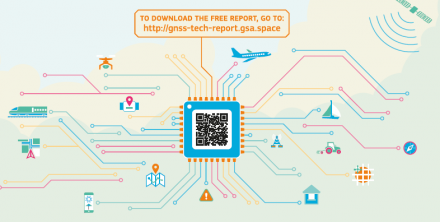The European GNSS Agency, in cooperation with the European Commission, is to hold a presentation of the second issue of its GNSS User Technology Report at the ION GNSS+ 2018 conference in Miami on Thursday 27 September.
The GSA publishes its 2018 GNSS User Technology  Report on 24 September 2018, taking an in-depth look at the latest in state-of-the-art GNSS receiver technology and providing expert analysis on the trends that will shape the global GNSS landscape in the coming years.
Report on 24 September 2018, taking an in-depth look at the latest in state-of-the-art GNSS receiver technology and providing expert analysis on the trends that will shape the global GNSS landscape in the coming years.
Since its launch in 2016, the GNSS User Technology Report has become the go-to-source for comprehensive information on the dynamic global GNSS technology industry. The Report also provides an in-depth look at applications and solutions within the mass market, transport safety- and liability-critical, and high precision and timing domains, with a focus on new exciting trends and drivers.
Be the first to benefit
The GSA is organising a side event at this year’s ION GNSS+ in Miami at which it will present key elements of the new Report. The presentation, which will be held at 14:00 in the Orchid Room of the Hyatt Regency Miami on 27 September, will be an opportunity to learn about breakthrough GNSS technology innovations expected in the coming years and to listen to testimonials from the chipset industry and application developers, who will present results from the use of dual frequency and PPP in the mass market.
Are you ready to take the pulse of the GNSS user technology industry and get an inside view on how the latest trends are changing the market? Then don’t miss out on this opportunity to be among the first to benefit from the insights in the new GNSS User Technology Report.
Some highlights from this year’s GNSS User Technology Report
-
All global and regional GNSS constellations are developing, modernising and innovating, with more than 100 GNSS satellites now available over our heads.
-
The vast majority of current receivers are multi-constellation, and the most popular way to provide multi-constellation support is to cover all available constellations. Today only around 30% of receivers use GPS only.
-
In the mass market domain, we are seeing a divide between chipsets optimised for ‘entry level’ IoT products, where energy per fix is the primary driver, and ‘high end’, where the industry is innovating to propose enhanced positioning performance.
-
The need for accuracy in the mass market is initiating new solutions, including ones based on Android GNSS raw measurements or, more significantly, using multi-frequency signals.
-
The frequencies supported across all application areas range from single L1/E1 to 4 frequencies in the professional segment. The dual frequency solution showing the most growth is L1/E1 and L5/E5, however the legacy L1/E1 and L2 are still being used.
-
Growing interest has been observed in PPP and RTK services proposed by private industry and public system operators, leading to new PPP/RTK concepts aiming to address a wide customer base beyond high precision.
-
The need to ensure both safety and security of PNT solutions is being highlighted by all solution providers, particularly in systems where humans are out of the control loop, such as in autonomous vessels, cars or drones.
ION GNSS+
ION GNSS+ is the world's largest technical meeting and showcase of GNSS technology, products and services. This year's conference will bring together international leaders in GNSS and related positioning, navigation and timing fields to present new research, introduce new technologies, discuss current policy, demonstrate products and exchange ideas.
The GSA GNSS User Technology Report won’t be officially launched until September 24, but you can already register to be automatically notified when it is available to download.
Media note: This feature can be republished without charge provided the European GNSS Agency (GSA) is acknowledged as the source at the top or the bottom of the story. You must request permission before you use any of the photographs on the site. If you republish, we would be grateful if you could link back to the GSA website (http://www.gsa.europa.eu).